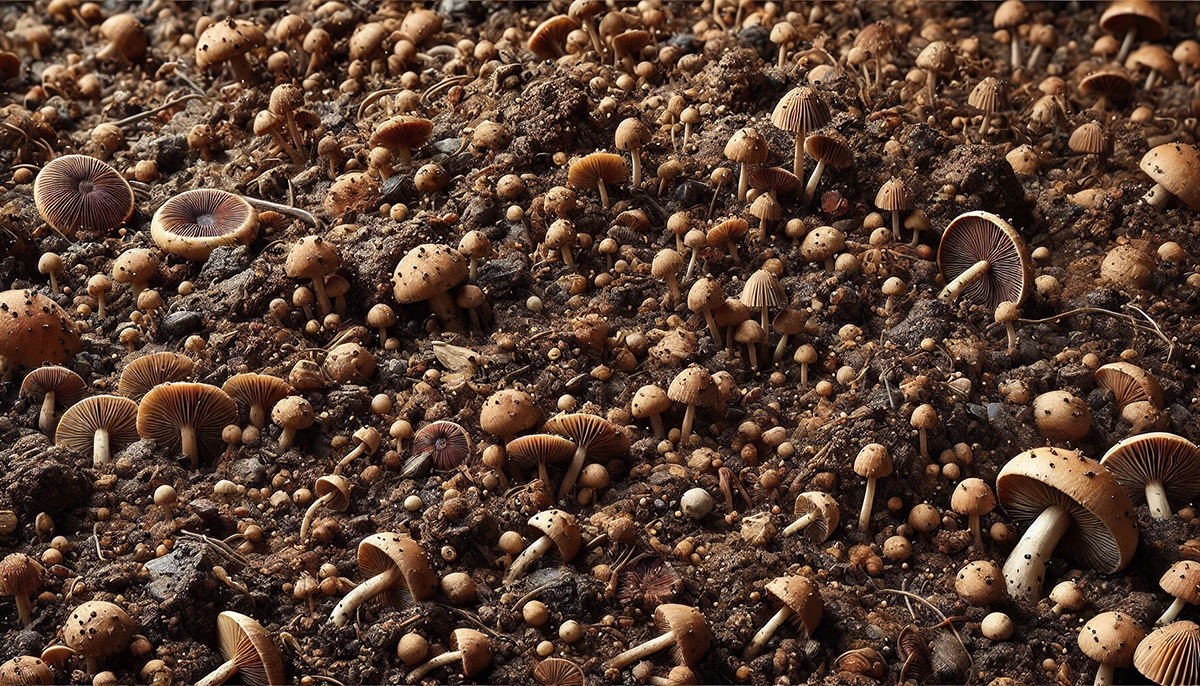Fungi in Soil: Causes & Effective Tips

Fungi in soil can be both beneficial and harmful. Certain fungi, such as mycorrhiza, promote plant growth and resilience, while others, like Botrytis or Fusarium, can cause significant issues.
To detect and counteract infestations early, it is essential to maintain a well-balanced growing environment. A healthy setting helps prevent harmful fungal infestations and supports optimal plant development.
Fungi in Soil: Beneficial or Harmful?
Soil is the foundation for healthy plants and serves as a habitat for numerous microorganisms, including fungi. These organisms can have a positive impact on plant growth or lead to complications.
Key Takeaways
-
Early detection and prevention of fungal infections are crucial for healthy plants.
-
A clean growing environment and microclimate control are essential to prevent unwanted fungal growth.
-
High-quality seeds and substrates contribute to plant health.
-
Effective measures against fungal infestations include removing infected plant parts and using targeted biological treatments.
-
Beneficial fungi like mycorrhiza improve soil structure and plant growth, while pathogens can cause plant diseases.
The Role of Fungi in the Growing System
Fungi play a vital role in soil biology. They break down organic matter and release essential nutrients that support plant development. Mycorrhizal fungi establish a symbiotic relationship with plant roots, enhancing water and nutrient absorption. However, harmful fungi like Fusarium or Pythium can attack the root system, impairing plant growth. Maintaining a balanced soil environment is key to harnessing the benefits of fungi while minimizing the risk of pathogenic infestations.
Causes of Fungal Growth
Fungi thrive under specific conditions. To prevent mold and other harmful fungi, the following factors should be managed:
High Humidity
High humidity levels encourage fungal growth. Mold fungi like Botrytis thrive in moist environments. When humidity exceeds 60%, the risk of infestation rises sharply. To counteract this, ensure good ventilation and maintain dry conditions in cultivation areas. Dehumidifiers and improved air circulation can help lower humidity levels.
Overwatering
Excessive watering creates an ideal environment for fungi. Waterlogged roots are prone to fungal infections, particularly from Fusarium and Pythium, which cause root rot. Ensuring proper soil drainage and allowing the substrate to dry between watering cycles can prevent such issues.
Nutrient Overload
An excessive supply of nutrients can weaken plants, making them more susceptible to fungal infections. Over-fertilization often leads to an imbalanced soil ecosystem, favoring pathogenic fungi. It is advisable to maintain a balanced fertilization strategy and regularly monitor soil pH levels.
Harmful Fungi and Their Effects
Root Damage
Fungi like Pythium and Fusarium attack the root system, disrupting water and nutrient uptake. This often results in stunted growth and weakened plant conditions. Early symptoms include wilting leaves and browning, decaying roots.
Increased Susceptibility to Disease
Fungal infections such as Verticillium wilt obstruct a plant’s water pathways, leading to irreversible damage. Infected plants often exhibit wilting symptoms even when the soil moisture level is sufficient.
Mold Formation
Botrytis-induced bud rot can cause severe crop losses. This fungus spreads rapidly in dense, poorly ventilated plant areas. Ensuring proper airflow and promptly removing affected plant parts are crucial to preventing further spread.
Preventive Measures Against Fungal Infestations
Optimized Watering
A well-regulated irrigation system is vital to preventing fungal growth. Watering should be done in a way that allows the substrate to dry between cycles. Drip irrigation systems help control water distribution effectively.
Use of Sterilized Substrates
Choosing the right substrate can prevent fungal infestations. Sterilized or heat-treated growing mediums are free from harmful spores and provide optimal conditions for plant health.
Improving Air Circulation
Fans and strategically placed ventilation systems reduce humidity and prevent the formation of damp microclimates that encourage mold growth. Consistent air movement significantly lowers the risk of fungal infestation.
Treatment and Removal of Fungi
Manual Removal
Infected plant parts should be promptly removed to prevent further spread. Tools should be disinfected after each use to avoid spreading spores.
Use of Biological Treatments
Neem oil or a baking soda solution can naturally combat fungi. Additionally, Trichoderma fungi serve as natural antagonists that help control fungal infections.
Conclusion
By implementing preventive measures such as optimal humidity control, balanced fertilization, and proper hygiene, fungal infections can be effectively avoided. The use of mycorrhizal fungi further promotes plant health. Those who consistently maintain a healthy growing environment reduce the risk of fungal infestations and ensure a successful harvest.
Recommenend Products on Cannadusa
Zauberstaub Organischer Feststoffdünger 10L - 49,00€
Spray & Stop Plant Regulator Spray - 35,00€
BioTabs Starterpack - 59,00€
© 2024 - 2025 Cannadusa. Powered by Medusa Engineering GmbH
• Impressum • AGB • Datenschutz • Compliance

